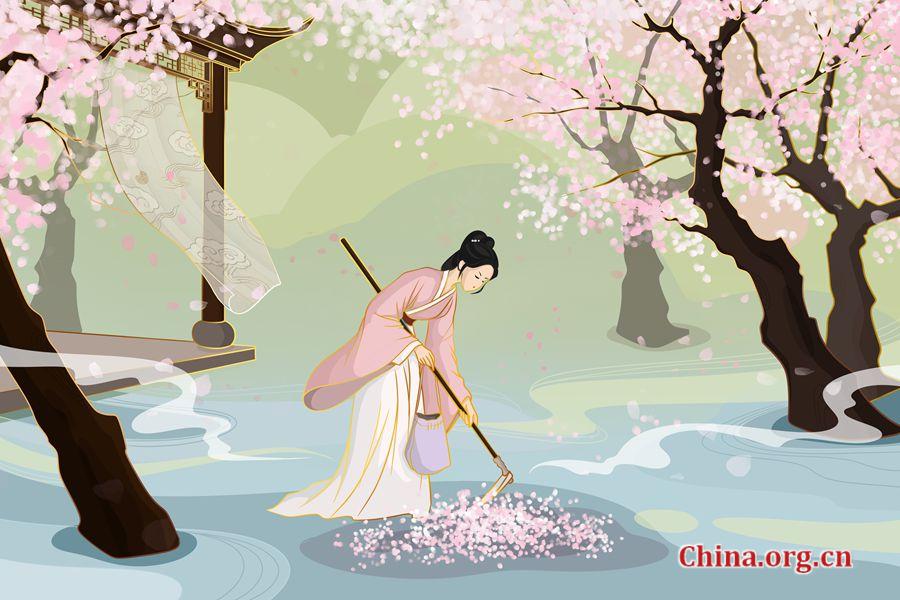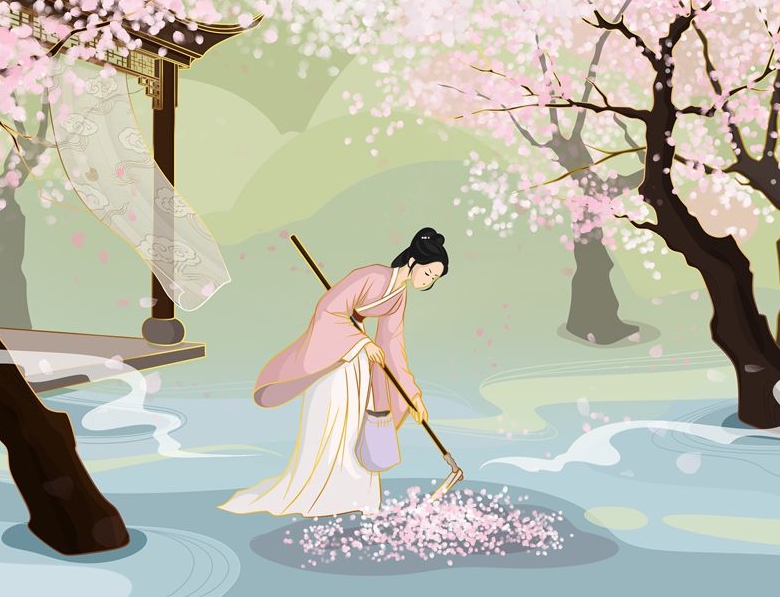
作者:王晓辉
中国诗词讲究平仄(level and oblique tones)、押韵(rhyme)、对仗(antithesis),英语诗歌讲究音步(meter/foot)、头韵(alliteration)、尾韵(end rhyme);汉字是单音节词,而英语既有单音节词,也有多音节词。这些特性决定了不论是汉诗英译还是英诗汉译,要想做到音与形的完美对应是不可能的。除了音与形,译者还要兼顾两种语言在抒情、意境、象征、寓意等方面的差异,凛乎其难矣!
钱钟书先生在《七缀集》中曾借用英语“the transmigration of souls”(投胎转世)来说明什么是好的译文,犹如“躯体换了一个,而精魂依然故我”。我理解钱先生的意思是,形可以不似,但神必须似,而且,那换了的“躯体”也一定是英语读者能够接受和欣赏的“躯体”。

【配图:彭靖雯】
霍克斯教授的《红楼梦》诗词翻译,就是transmigration of souls的典范。我们先来看看林黛玉《葬花吟》的前四句的翻译:
花谢花飞花满天,
红消香断有谁怜?
游丝软系飘春榭,
落絮轻沾扑绣帘。
……
这是一首“长古”,有五十多句,因为太长,无法像绝句或律诗那样一韵到底,一般每四句会换韵。限于篇幅,我们只讨论这四句。
霍克斯教授的译文:
The blossoms fade and falling fill the air,
Of fragrance and bright hues bereft and bare.
Floss drifts and flutters round the Maiden's bower,
Or softly strikes against her curtained door.
霍克斯教授用非常优美、齐整的双韵体翻译了这四句诗,每句五个音步,按aabb的格式押韵。第一句,“花谢花飞花满天”(The blossoms fade and falling fill the air),fade、falling、fill三个流畅的“f”头韵的单词,不仅翻译出了“谢”“飞”“(飞)满天”三个动词,而且从声音效果上也很容易让读者联想到花落和风吹的声音。第二句“红消香断有谁怜”(Of fragrance and bright hues bereft and bare),bright、bereft、bare又是三个连续头韵,一气呵成。正常语序应该是bereft of fragrance and bright hues and bare,写成诗的语言时调整了次序。bereft of是失去的意思,bright hues是鲜艳的色彩,我认为霍克斯没有用red或者red color来翻译“红”是有考虑的。汉语是高度概括的语言,常用“红”来指代花或花的颜色;英语是非常具象的语言,red就是具体的红。如果直译,意思就变窄了,况且《红楼梦》第二十七回中明确交代,“凤仙石榴等各色落花”落了一地,仅用一个red来翻译,显然不够。第三、四句“游丝软系飘春榭,落絮轻沾扑绣帘”(Floss drifts and flutters round the Maiden's bower, or softly strikes against her curtained door),“bower”与“door”基本押韵,“floss”和“flutters”延续使用第一句的头韵“f”,读起来如流水潺潺,气韵不断,仿佛落花仍在庭前帘外随风飞舞。
澳洲国立大学副教授范圣宇博士在他的英文专著The Translator's Mirror for the Romantic: Cao Xueqin's Dream and David Hawkes' Stone (《译者的风月宝鉴:曹雪芹的〈红楼梦〉与霍克斯的〈石头记〉》)中,例举了一首探春咏大观园的诗,题为《万象争辉》:
名园筑就势巍巍,
奉命何惭学浅微。
精妙一时言不出,
果然万物有光辉。
这是一首应景之作,水平一般,但霍克斯教授的翻译却很不一般:
All Things Bright and Beautiful
The finished garden is a wondrous sight.
Unlettered and unskilled, I blush to write.
Its marvels are not in one phrase expressed,
Yet "Bright and Beautiful" I judge the best.
All Things Bright and Beautiful是一首基督教徒颂扬上帝的歌,在英国和美国连小孩子都会唱,霍克斯教授信手拈来,用来翻译“万象争辉”,恰到好处:
All things bright and beautiful,
All creatures great and small,
All things wise and wonderful,
The Lord God made them all.
这首赞美诗的大意是:
万事皆美好,
万物有大小;
万事尽精妙,
皆为上帝造。
霍克斯教授将All things bright and beautiful中的bright and beautiful整体切割,移植到译文中,Its marvels are not in one phrase expressed, yet "Bright and Beautiful" I judge the best(大观园的美景难以言表,最恰当的词汇就是“Bright and Beautiful”)。英语读者看到这里,一定会想起小时候在教堂里唱的赞美诗,原诗所要表达的意思与译文实现了“无缝对接”,达到了翻译追求的最高境界。
曹雪芹在《红楼梦》中穿插了220多首诗词和大量的匾额、楹联,霍克斯教授凭借着深湛的语言和文化功底,给出了教科书级的翻译,甚至连叙事文字中出现的对偶的句子,他都按照诗词的规矩进行翻译,最大程度上保留了传统中华文化的韵味。
第二十六回,林黛玉去怡红院串门,不料被丫鬟拒之门外,误以为宝玉有意疏远她,便“越想越伤感起来,也不顾苍苔露冷,花径风寒,独立墙角边花阴之下,悲悲戚戚呜咽起来。”
霍克斯译文:
The more she thought about it the more distressed she became.
Chill was the green moss pearled with dew
And chill was the wind in the avenue;
but Dai-yu, all unmindful of the unwholesome damp, had withdrawn into the shadow of a flowering fruit-tree by the corner of the wall, and grieving now in real earnest, began to cry as though her heart would break.
别的不说,单说“苍苔露冷,花径风寒”这两句,如果换了我,十有九成会译成It was chill and windy outside the courtyard。话说回来,我也没有资格翻译《红楼梦》。霍克斯教授知道这两个整齐的对偶句是这段话的精彩之处,所以,他还是用诗的语言将其译出:
Chill was the green moss pearled with dew
And chill was the wind in the avenue;
两句英文都是八个单词,齐齐整整,而且dew与avenue还押韵,即使是不懂中文的英语读者也能立刻感受到中国文学独特的文字与音韵之美。
著名汉学家、翻译家、哈佛大学亚洲系主任海陶玮教授(James R. Hightower)在霍克斯英译本《楚辞》再版的序言中做过这样的评价:Translators of Chinese poetry can be divided into convenient categories: those who know Chinese and those who don't (the majority, alas); those who can write English and those who can't; those with a knowledge of literary tradition and those without it. Mr. Hawkes is that rarest of translators: one who knows Chinese and Chinese literature and who can write literate English. (翻译中国诗的译者,可以大致分为:懂汉语的和不懂汉语的;能用英语写作的和不能的;有文化传统知识的和没有的。霍克斯属于极少数的那一类译者:既懂汉语又懂中国文学,而且还能写出优美典雅的英语。)
霍克斯教授用西方读者最为熟悉的诗歌形式来翻译中国的诗词,做到了钱钟书先生所说的“投胎转世”(the transmigration of souls)。他的译诗就像西方语言外壳包裹着一个“中国芯”,行云流水,润物无声,中国故事,国际表达。

Go to Forum >>0 Comment(s)